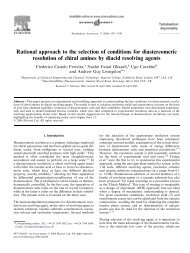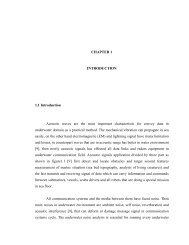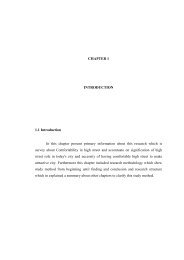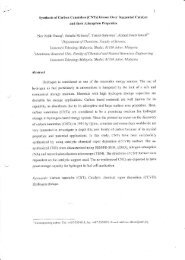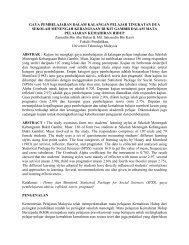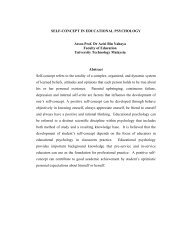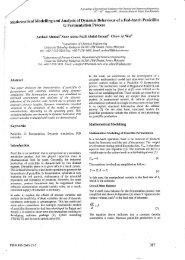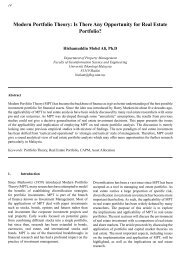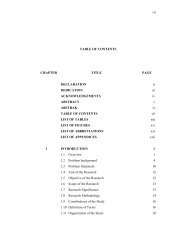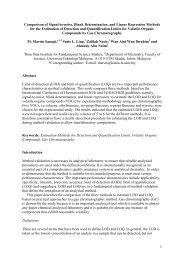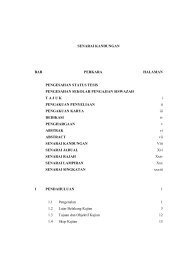The Strengths and Limitations of Risk Measures in Real Estate: A ...
The Strengths and Limitations of Risk Measures in Real Estate: A ...
The Strengths and Limitations of Risk Measures in Real Estate: A ...
You also want an ePaper? Increase the reach of your titles
YUMPU automatically turns print PDFs into web optimized ePapers that Google loves.
68<br />
Abstract<br />
<strong>The</strong> <strong>Strengths</strong> <strong>and</strong> <strong>Limitations</strong> <strong>of</strong> <strong>Risk</strong> <strong>Measures</strong> <strong>in</strong> <strong>Real</strong> <strong>Estate</strong>: A<br />
Review<br />
Chyi L<strong>in</strong> Lee<br />
Centre <strong>of</strong> <strong>Real</strong> <strong>Estate</strong> Studies<br />
Faculty <strong>of</strong> Geo<strong>in</strong>formation Science <strong>and</strong> Eng<strong>in</strong>eer<strong>in</strong>g<br />
Universiti Teknologi Malaysia<br />
81310 Skudai, Johor, Malaysia<br />
chyil<strong>in</strong>@fksg.utm.my<br />
<strong>The</strong> purpose <strong>of</strong> this paper is to provide a brief overview <strong>of</strong> the concept <strong>of</strong> risk measures that used <strong>in</strong> real estate with<br />
a particular emphasis on the merits <strong>and</strong> drawbacks <strong>of</strong> these risk measures. <strong>The</strong> f<strong>in</strong>d<strong>in</strong>g reveals that each risk measure<br />
has its dist<strong>in</strong>ctions <strong>and</strong> limitations. <strong>The</strong> f<strong>in</strong>d<strong>in</strong>g has a far-reach<strong>in</strong>g implication to <strong>in</strong>vestors, particularly, <strong>in</strong>stitutional<br />
<strong>in</strong>vestors, which they should conscious with the advantages <strong>and</strong> disadvantages <strong>of</strong> these risk measures <strong>in</strong> order to<br />
determ<strong>in</strong>e the most apt risk measure <strong>in</strong> formulat<strong>in</strong>g desirable risk <strong>in</strong>vestment strategy.<br />
Keywords: <strong>Risk</strong> <strong>Measures</strong>, Variance <strong>and</strong> Investment <strong>Risk</strong><br />
1. Introduction<br />
Nowadays, variance is the most popular risk measure,<br />
which has been employed widely <strong>in</strong> many real estate <strong>and</strong><br />
f<strong>in</strong>ance studies; <strong>and</strong> it is also the most popular risk measure<br />
for <strong>in</strong>vestors (Evans, 2004). Interest<strong>in</strong>gly, variance is not<br />
the only risk measure, while there are several fruitful<br />
alternatives that can be used as risk measure <strong>in</strong> current<br />
real estate literature.<br />
<strong>The</strong>se alternative risk measures are Lower Partial<br />
Moment (downside risk) (LPM), Mean Absolute<br />
Deviation (MAD), M<strong>in</strong>imax <strong>and</strong> Maximum Drawdwon<br />
(MaxDD). However, these risk measures have not<br />
received overwhelm<strong>in</strong>g response as variance <strong>in</strong> f<strong>in</strong>ance<br />
<strong>and</strong> real estate literature. Does variance is the best risk<br />
measure? If not, which risk measure is the ‘best’ risk<br />
measure?<br />
Unfortunately, the determ<strong>in</strong>ation <strong>of</strong> the best risk measure<br />
that <strong>of</strong>fer the best return <strong>and</strong> risk trade-<strong>of</strong>f might be a<br />
va<strong>in</strong> exercise unless a common risk measure is identified<br />
(Cheng <strong>and</strong> Wolverton, 2001; Byrne <strong>and</strong> Lee, 2004).<br />
<strong>The</strong> difficulty for determ<strong>in</strong><strong>in</strong>g it is also demonstrated by<br />
the Cheng <strong>and</strong> Wolverton (2001) <strong>and</strong> Cheng (2001) <strong>in</strong><br />
which they reveal that downside risk <strong>and</strong> variance are<br />
not directly comparable. As such, it is implausible to<br />
conclude which risk measure is superior that others.<br />
Additionally, Biglova et al., (2004) <strong>and</strong> Byrne <strong>and</strong> Lee<br />
(2004) also reveal empirical evidences that different<br />
risk measures provide different portfolio allocation <strong>and</strong><br />
different performance result for an asset. <strong>The</strong>se f<strong>in</strong>d<strong>in</strong>gs<br />
have a practical implication to <strong>in</strong>vestors that the choice <strong>of</strong><br />
the risk measure depends on the <strong>in</strong>vestors’ risk attitudes<br />
<strong>and</strong> <strong>in</strong>vestment objectives.<br />
<strong>The</strong>refore, underst<strong>and</strong><strong>in</strong>g the concept, dist<strong>in</strong>ctions <strong>and</strong><br />
drawbacks <strong>of</strong> each different risk measure is <strong>in</strong>evitable<br />
for <strong>in</strong>vestors. In this way, they can select the most<br />
appropriate risk measure accord<strong>in</strong>g to their <strong>in</strong>vestment<br />
objectives <strong>and</strong> attitudes toward risk.<br />
<strong>The</strong> purpose <strong>of</strong> this paper is to provide a brief overview<br />
on the concept <strong>of</strong> risk measures that employed <strong>in</strong> real<br />
estate <strong>and</strong> determ<strong>in</strong>e the advantages <strong>and</strong> disadvantages<br />
<strong>of</strong> these measures. In Section 2, the concept <strong>of</strong> available<br />
risk measures, the strengths <strong>and</strong> weaknesses <strong>of</strong> these risk<br />
measures are discussed. <strong>The</strong> choice <strong>of</strong> risk measures is<br />
discussed <strong>in</strong> Section 3 <strong>in</strong> which it provides a review for
<strong>in</strong>vestors on the appropriate risk measures <strong>in</strong> different<br />
circumstances. Section 4 concludes <strong>and</strong> provides the<br />
future research direction.<br />
2. <strong>Risk</strong> <strong>Measures</strong><br />
Many studies have proposed alternative risk measures <strong>in</strong><br />
l<strong>in</strong>e with the motivation for overcom<strong>in</strong>g the limitations <strong>of</strong><br />
variance. At least four alternative risk measures, namely<br />
Lower Partial Moment (LPM), Mean Absolute Deviation<br />
(MAD), M<strong>in</strong>imax, <strong>and</strong> Maximum Drawdown (MaxDD)<br />
are found <strong>in</strong> real estate literature.<br />
2.1 Variance<br />
S<strong>in</strong>ce the <strong>in</strong>troduction <strong>of</strong> Mean Variance (MV) Analysis<br />
by Markowitz (1952), Variance (or St<strong>and</strong>ard deviation)<br />
is the most common risk measure that is used by<br />
practitioners <strong>and</strong> researchers (Evans, 2004). Variance<br />
is measured by the dispersion <strong>of</strong> a return distribution<br />
around the mean or average. While, st<strong>and</strong>ard deviation is<br />
the square root <strong>of</strong> the variance. It is def<strong>in</strong>ed as follow:<br />
(1)<br />
where R i is the return for asset i , is the average (mean)<br />
<strong>of</strong> the returns <strong>and</strong> T is number <strong>of</strong> returns. Notably, most<br />
<strong>of</strong> the studies on f<strong>in</strong>ance <strong>and</strong> real estate are deal<strong>in</strong>g with<br />
the sample rather than population, hence, the sum <strong>of</strong> the<br />
square deviations should be divided by T - 1 rather than<br />
(Strong, 2003).<br />
It should be noted that MV model has several strict<br />
assumptions such as asset return distribution must be<br />
normally distributed <strong>and</strong> all <strong>in</strong>vestors have a constant<br />
quadratic utility function 2 . However, substantial studies<br />
have demonstrated that returns from real estate are not<br />
necessarily normally distributed (Myer <strong>and</strong> Webb, 1993,<br />
1994 for U.S. commercial real estate <strong>and</strong> <strong>Real</strong> <strong>Estate</strong><br />
Investment Trusts; Graff et al., 1997, Lee, 2006 <strong>and</strong><br />
Peng, 2005 for Australian commercial real estate <strong>and</strong><br />
Listed Property Trusts; Maitl<strong>and</strong>-Smith <strong>and</strong> Brooks,<br />
1999 for commercial real estate <strong>in</strong> U.K.; Lee et al.,<br />
2006 for Malaysian property shares). Besides, Fishburn<br />
(1977), Harr<strong>in</strong>gton (1987), Nawrocki (1999) <strong>and</strong> Sharpe<br />
<strong>and</strong> Alex<strong>and</strong>er (1990) also argue that no compell<strong>in</strong>g<br />
reason for assum<strong>in</strong>g all <strong>in</strong>vestors have a static quadratic<br />
utility function.<br />
1 A normal/symmetrical distribution assumption allows MV model<br />
can be completely described by mean <strong>and</strong> variance (the first two central<br />
moments) (Brown <strong>and</strong> Matysiak, 2000).<br />
2 Quadratic utility function assumes all <strong>in</strong>vestors are risk averse.<br />
2.2 Lower Partial Moment<br />
69<br />
Lower Partial Moment (LPM) is also known as downside<br />
risk. It relies upon safety first rule, which is developed<br />
by Roy (1952). It measures only the likelihood <strong>of</strong> bad<br />
outcomes that is the likelihood <strong>of</strong> return below the target<br />
return for an <strong>in</strong>vestment. 4 It must be noted that semivariance<br />
is a special case <strong>of</strong> the LPM <strong>in</strong> which the value<br />
is equal to 2 (Harlow, 1991). Accord<strong>in</strong>g to Bawa (1975)<br />
<strong>and</strong> Fishburn (1977), n-degree Lower Partial Moment<br />
can be written as:<br />
(2)<br />
where dF(R) is the cumulative distribution function <strong>of</strong><br />
the <strong>in</strong>vestment return R, is the target return, is the<br />
degree <strong>of</strong> the LPM, R it is the return for asset at time <strong>and</strong><br />
T is number <strong>of</strong> returns.<br />
While, there is another LPM measure that is generalised<br />
or asymmetric co-LPM (CLPM). It is proposed by Hogan<br />
<strong>and</strong> Warren (1974) <strong>and</strong> Bawa <strong>and</strong> L<strong>in</strong>derberg (1977). <strong>The</strong><br />
measure for CLPM is def<strong>in</strong>ed as:<br />
(3)<br />
where is the target rate <strong>of</strong> return, R it <strong>and</strong> R jt are the rate<br />
<strong>of</strong> return <strong>of</strong> the asset i <strong>and</strong> j at time t, T is the total number<br />
<strong>of</strong> returns, <strong>and</strong> is the degree <strong>of</strong> CLPM. 5<br />
Symmetric co-LPM (SLPM), a simple algorithm for<br />
calculat<strong>in</strong>g downside risk is proposed by Nawrocki<br />
(1991). <strong>The</strong> SLPM is written as follows:<br />
3<br />
See also Pratt (1964); Arrow (1971); Wippern (1971) <strong>and</strong> Sarnat<br />
(1974) for the details on the limitations <strong>of</strong> quadratic utility function that<br />
is used to describe the actual behaviour <strong>of</strong> <strong>in</strong>vestors.<br />
4<br />
Markowitz (1959) also recognises the importance <strong>of</strong> this argument<br />
<strong>and</strong> suggests us<strong>in</strong>g semi-variance.<br />
5<br />
CLPM is an asymmetric measure <strong>and</strong> is not equal<br />
to . See also Nawrocki (1999) <strong>and</strong> Lee et al. (2006)<br />
for details.<br />
(4)
70<br />
where i,j is the correlation coefficient between the return<br />
<strong>of</strong> asset i <strong>and</strong> j , is the target rate <strong>of</strong> return, R i <strong>and</strong> R j<br />
are the return <strong>of</strong> the asset i <strong>and</strong> j, T is the total number <strong>of</strong><br />
returns, <strong>and</strong> is the degree <strong>of</strong> SLPM.<br />
<strong>The</strong> advantages <strong>of</strong> the LPM have been demonstrated <strong>in</strong><br />
many studies. In general, LPM appears some theoretical<br />
superiorities such as no assumption on asset return<br />
distribution <strong>and</strong> liberates <strong>in</strong>vestors from the assumption<br />
<strong>of</strong> quadratic utility function (Lee et al., 2005). Byrne<br />
<strong>and</strong> Lee (2004), however, argue that LPM sensitive to<br />
observations that are distant from their target. Besides,<br />
Konno et al. (2002) show that it <strong>in</strong>volves the prolonged<br />
computation time for large scale portfolio optimisation.<br />
Hamel<strong>in</strong>k <strong>and</strong> Hosli (2004) also argue that it does not<br />
consider the issue <strong>of</strong> serial correlation <strong>of</strong> returns 6 .<br />
2.3 Mean Absolute Deviation<br />
Mean Absolute Deviation (MAD) is proposed by Konno<br />
(1989), which is used to overcome the limitations <strong>of</strong><br />
Mean Variance (MV) model. <strong>The</strong> MAD can be computed<br />
from the follow<strong>in</strong>g:<br />
(5)<br />
Where R i is the return asset i, E(R i ) is the expected return<br />
or mean <strong>and</strong> T is the total number <strong>of</strong> returns.<br />
<strong>The</strong> MAD measure has a number <strong>of</strong> attractive features<br />
such as bypass the covariance matrix computation <strong>and</strong><br />
easier solv<strong>in</strong>g algorithm (portfolio optimisation). So it<br />
requires a shorter computation time <strong>and</strong> improves the<br />
computation <strong>of</strong> optimal portfolios. Moreover, MAD<br />
is more stable over time than variance which it is less<br />
sensitive to outliers <strong>and</strong> it does not require any assumption<br />
on the shape <strong>of</strong> a distribution. Interest<strong>in</strong>gly, it reta<strong>in</strong>s all<br />
the positive features <strong>of</strong> the MV model. MAD is also apt<br />
to be used <strong>in</strong> situations when the number <strong>of</strong> assets (N) is<br />
greater than the number <strong>of</strong> time periods (T) (Konno &<br />
Yamazaki, 1991; Byrne <strong>and</strong> Lee, 1997, 2004; Brown <strong>and</strong><br />
Matysiak, 2000; Konno, 2003).<br />
However, the computation time is less significant<br />
nowadays due to the advancement <strong>of</strong> computer.<br />
Additionally, the use <strong>of</strong> MAD is precluded <strong>in</strong> l<strong>in</strong>e with<br />
the f<strong>in</strong>d<strong>in</strong>gs <strong>of</strong> Simaan (1997) <strong>in</strong> which the ignorance <strong>of</strong><br />
the covariance matrix leads greater estimation risk that<br />
outweighs the benefits.<br />
6 Serial correlation (smooth<strong>in</strong>g) is a flaw with real estate, particularly<br />
when estimat<strong>in</strong>g the returns from <strong>in</strong>dices. See Blundell <strong>and</strong> Ward<br />
(1987); MacGregor <strong>and</strong> Nanthakumaran (1992); Geltner (1993); Newell<br />
<strong>and</strong> MacFarlane (1995, 1996) <strong>and</strong> Brown <strong>and</strong> Matysiak (1996, 2000) for<br />
the smooth<strong>in</strong>g effect <strong>and</strong> the desmooth<strong>in</strong>g techniques.<br />
2.4 M<strong>in</strong>imax<br />
Young (1998) proposes a new pr<strong>in</strong>ciple for portfolio<br />
selection rule us<strong>in</strong>g a simple l<strong>in</strong>ear programm<strong>in</strong>g solution,<br />
which is M<strong>in</strong>imax. <strong>The</strong> rule uses m<strong>in</strong>imum return as a<br />
measure <strong>of</strong> risk rather than variance.<br />
A M<strong>in</strong>imax portfolio is def<strong>in</strong>ed “as m<strong>in</strong>imis<strong>in</strong>g the<br />
maximum loss, where loss is def<strong>in</strong>ed as negative ga<strong>in</strong>,<br />
or, alternatively, maximizes the m<strong>in</strong>imum ga<strong>in</strong>.” (Young,<br />
1998: 674). In other words, M<strong>in</strong>imax can be viewed as an<br />
extreme <strong>and</strong> special case <strong>of</strong> the Conditional Value at <strong>Risk</strong><br />
as it represents the maximum loss over all past historical<br />
returns (Biglova et al., 2004). <strong>The</strong> solution for M<strong>in</strong>imax<br />
portfolio is as follows:<br />
Subject to:<br />
(6)<br />
where r it is return <strong>of</strong> asset i <strong>in</strong> time period t, i is average<br />
return on asset i, w i is portfolio allocation to security i, M p<br />
is m<strong>in</strong>imum return on portfolio, subject to the constra<strong>in</strong>t<br />
that average return on portfolio exceeds some m<strong>in</strong>imum<br />
level, say G , <strong>and</strong> that the sum <strong>of</strong> the portfolio allocations<br />
less than the total allocation, say W .<br />
Such model has a number <strong>of</strong> superiorities by compar<strong>in</strong>g<br />
with MV model such as it reta<strong>in</strong>s the positive features<br />
<strong>of</strong> MV model if the return distribution is normally<br />
distributed. Furthermore, the complex decision variables<br />
can be accommodated <strong>in</strong> the model. It also liberates<br />
<strong>in</strong>vestors from the assumption <strong>of</strong> asset return distribution<br />
is normally distributed <strong>and</strong> it more consistent with<br />
<strong>in</strong>vestors’ utility functions, particularly, <strong>in</strong>vestors who<br />
have a strong aversion to downside risk (Young, 1998).<br />
However, M<strong>in</strong>imax rule is subject to the limitation <strong>of</strong><br />
requir<strong>in</strong>g sufficient historical data on the past returns<br />
<strong>and</strong> a predictive probability model for future returns. If<br />
not, M<strong>in</strong>imax rule is not appropriate to be used (Young,<br />
1998). Moreover, Byrne <strong>and</strong> Lee (2004) also argue that<br />
M<strong>in</strong>imax is sensitive to outliers <strong>of</strong> the data because it
specifically m<strong>in</strong>imises the maximum loss (negative<br />
return).<br />
2.5 Maximum Drawdown<br />
<strong>The</strong> Maximum Drawdown (MaxDD) is def<strong>in</strong>ed as “the<br />
loss suffered when an asset is bought at a local maximum,<br />
<strong>and</strong> sold at the next local m<strong>in</strong>imum.” (Hamel<strong>in</strong>k <strong>and</strong><br />
Hosli, 2004: 6). <strong>The</strong> MaxDD evaluated at time T is<br />
def<strong>in</strong>ed as:<br />
(10)<br />
where P(t) is the price at time t <strong>and</strong> P max (t) is the<br />
maximum <strong>of</strong> all prices <strong>in</strong> overall to this po<strong>in</strong>t <strong>in</strong> time:<br />
P max (t) = max t
72<br />
While, MaxDD emerges as an ideal risk measure for<br />
those need a time-dependence risk measure <strong>and</strong> it is the<br />
only risk measure that takes <strong>in</strong>to the account the serial<br />
correlations are found <strong>in</strong> the return series.<br />
4. Conclusion<br />
In this paper, risk measures that have been employed for<br />
measur<strong>in</strong>g the risk<strong>in</strong>ess <strong>of</strong> real estate are reviewed. <strong>The</strong><br />
advantages <strong>and</strong> disadvantages <strong>of</strong> each risk measure are<br />
also determ<strong>in</strong>ed.<br />
In general, there are several alternative risk measures<br />
that have been used <strong>in</strong> real estate literature <strong>and</strong> each<br />
risk measure has its strengths <strong>and</strong> limitations. As<br />
such, underst<strong>and</strong><strong>in</strong>g the merits <strong>and</strong> drawbacks <strong>of</strong> these<br />
risk measures will assist <strong>in</strong>vestors to select the most<br />
appropriate risk measure <strong>in</strong> formulat<strong>in</strong>g a desirable risky<br />
<strong>in</strong>vestment strategy accord<strong>in</strong>gly their <strong>in</strong>vestment criteria<br />
<strong>and</strong> objectives.<br />
However, researchers should cont<strong>in</strong>ue to make<br />
contributions <strong>in</strong> the area <strong>of</strong> the way <strong>in</strong> which survey<strong>in</strong>g<br />
the acceptance level <strong>of</strong> these risk measures <strong>in</strong> practice.<br />
Additionally, the endeavours should be expended to<br />
employ other alternative risk measures such as Value at<br />
<strong>Risk</strong> <strong>and</strong> Conditional Value at <strong>Risk</strong> to real estate market.<br />
References<br />
Acar, E. & James, S. (1997) Maximum Loss <strong>and</strong><br />
Maximum Drawdown <strong>in</strong> F<strong>in</strong>ancial Markets. International<br />
Conference on Forecast<strong>in</strong>g F<strong>in</strong>ancial Markets (London,<br />
Banque Nationale de Paris <strong>and</strong> Imperial College)<br />
Arrow, K.J. (1971) Essays <strong>in</strong> the <strong>The</strong>ory <strong>of</strong> <strong>Risk</strong>-bear<strong>in</strong>g<br />
(Amsterdam, North-Holl<strong>and</strong> Pub. Co.).<br />
Bawa, V.S. (1975) Optimal Rules for Order<strong>in</strong>g Uncerta<strong>in</strong><br />
Prospects, Journal <strong>of</strong> F<strong>in</strong>ancial Economics, 2(1): 95-<br />
121.<br />
Bawa, V.S. & L<strong>in</strong>derberg, E.B. (1977) Capital Market<br />
Equilibrium <strong>in</strong> a Mean-Lower Partial Moment<br />
Framework, Journal <strong>of</strong> F<strong>in</strong>ancial Economics, 5(2): 189-<br />
200.<br />
Biglova, A., Ortobelli, S., Rachev, S. & Stoyanov, S.<br />
(2004) Different Approaches to <strong>Risk</strong> Estimation <strong>in</strong><br />
Portfolio <strong>The</strong>ory, Journal <strong>of</strong> Portfolio Management,<br />
31(1): 103-112.<br />
Blundell, G.F. & Ward, C.W.R. (1987) Property Portfolio<br />
Allocation: A Multi-factor Model, L<strong>and</strong> Development<br />
Studies, 4(2): 145-156.<br />
Brown, G.R. & Matysiak, G.A. (1996) A Note on the<br />
Periodic Conversion <strong>of</strong> <strong>Measures</strong> <strong>of</strong> <strong>Risk</strong>, Journal <strong>of</strong><br />
Property Research, 13(1): 13-16.<br />
Brown, G.R. & Matysiak, G.A. (2000) <strong>Real</strong> <strong>Estate</strong><br />
Investment: A Capital Market Approach (Harlow,<br />
F<strong>in</strong>ancial Times Prentice Hall).<br />
Byrne, P. & Lee, S. (1997) <strong>Real</strong> <strong>Estate</strong> Portfolio Analysis<br />
under Conditions <strong>of</strong> Non-Normality: <strong>The</strong> Case <strong>of</strong><br />
NCREIF, Journal <strong>of</strong> <strong>Real</strong> <strong>Estate</strong> Portfolio Management,<br />
3(1): 37-46.<br />
Byrne, P. & Lee, S. (2004) Different <strong>Risk</strong> <strong>Measures</strong>:<br />
Different Portfolio Compositions?, Journal <strong>of</strong> Property<br />
Investment <strong>and</strong> F<strong>in</strong>ance, 22(6): 501-511.<br />
Cheng, P. (2001) Compar<strong>in</strong>g Downside-<strong>Risk</strong> <strong>and</strong> Mean-<br />
Variance Analysis Us<strong>in</strong>g Bootstrap Simulation, Journal<br />
<strong>of</strong> <strong>Real</strong> <strong>Estate</strong> Portfolio Management, 7(3): 225-238<br />
Cheng, P. & Wolverton, M.L. (2001) MPT <strong>and</strong> the<br />
Downside <strong>Risk</strong> Framework: A Comment on Two Recent<br />
Studies, Journal <strong>of</strong> <strong>Real</strong> <strong>Estate</strong> Portfolio Management,<br />
7(2): 125-131.<br />
Evans, J.L. (2004) Wealthy Investor Attitudes,<br />
Expectations, <strong>and</strong> Behaviors toward <strong>Risk</strong> <strong>and</strong> Return,<br />
<strong>The</strong> Journal <strong>of</strong> Wealth Management, 7(1): 12-18.<br />
Fishburn, P.C. (1977) Mean-<strong>Risk</strong> Analysis with <strong>Risk</strong><br />
Associated with Below-Target Returns, American<br />
Economic Review, 67(2): 116-126.<br />
Geltner, D.M. (1993) Estimat<strong>in</strong>g Market Values from<br />
Appraisal Values without Assum<strong>in</strong>g an Efficient Market,<br />
Journal <strong>of</strong> <strong>Real</strong> <strong>Estate</strong> Research, 8(3): 325-345.<br />
Graff, R.A., Harr<strong>in</strong>gton, A. & Young, M.S. (1997) <strong>The</strong><br />
Shape <strong>of</strong> Australian <strong>Real</strong> <strong>Estate</strong> Return Distributions <strong>and</strong><br />
Comparisons to the United States, Journal <strong>of</strong> <strong>Real</strong> <strong>Estate</strong><br />
Research, 14(3): 291-308.<br />
Hamel<strong>in</strong>k, F. & Hosli, M. (2004) Maximum Drawdown<br />
<strong>and</strong> the Allocation to <strong>Real</strong> <strong>Estate</strong>, Journal <strong>of</strong> Property<br />
Research, 21(1): 5-29.<br />
Harlow, W.V. (1991) Asset Allocation <strong>in</strong> a Downside-<br />
<strong>Risk</strong> Framework, F<strong>in</strong>ancial Analysts Journal, 47(5): 28-<br />
40.<br />
Harr<strong>in</strong>gton, D.R. (1987) Modern Portfolio <strong>The</strong>ory, <strong>The</strong><br />
Capital Asset Pric<strong>in</strong>g Model, <strong>and</strong> Arbitrage Pric<strong>in</strong>g<br />
<strong>The</strong>ory: A User’s Guide (Englewood Cliffs, Prentice-
Hall).<br />
Hogan, W.W. & Warren, J.M. (1974) Toward <strong>The</strong><br />
Development <strong>of</strong> an Equilibrium Capital-Market Model<br />
Based On Semivariance, Journal <strong>of</strong> F<strong>in</strong>ancial <strong>and</strong><br />
Quantitative Analysis, 9(1): 1-11.<br />
Johansen, A. & Sornette, D. (2001) Large Stock Market<br />
Price Drawdowns Are Outliers, Journal <strong>of</strong> <strong>Risk</strong>, 4(2): 69-<br />
110.<br />
Konno, H. (1989) Piecewise L<strong>in</strong>ear <strong>Risk</strong> Functions<br />
<strong>and</strong> Portfolio Optimisation, Journal <strong>of</strong> the Operations<br />
Research Society <strong>of</strong> Japan, 33: 139-156.<br />
Konno, H. (2003) Portfolio Optimization <strong>of</strong> Small<br />
Scale Fund Us<strong>in</strong>g Mean-Absolute Deviation Model,<br />
International Journal <strong>of</strong> <strong>The</strong>oretical <strong>and</strong> Applied<br />
F<strong>in</strong>ance, 6(4): 403-418.<br />
Konno, H., Waki, H. & Yuuki, A. (2002) Portfolio<br />
Optimization under Lower Partial <strong>Risk</strong> <strong>Measures</strong>, Asia-<br />
Pacific F<strong>in</strong>ancial Markets, 9(2): 127-140.<br />
Konno, H. & Yamazaki, H. (1991) Mean-Absolute<br />
Deviation Portfolio Optimization Model And Its<br />
Applications To Tokyo Stock Market, Management<br />
Science, 37(5): 519-531.<br />
Lee, C.L. (2006) Downside <strong>Risk</strong> Analysis <strong>in</strong> Australian<br />
Commercial Property, Australian Property Journal,<br />
39(1): 16-20.<br />
Lee, C.L., Rob<strong>in</strong>son, J. & Reed, R. (2005) Mean Variance<br />
Analysis versus Downside <strong>Risk</strong> Framework: Review<strong>in</strong>g<br />
the Application <strong>of</strong> Both Frameworks <strong>in</strong> <strong>Real</strong> <strong>Estate</strong><br />
Market. <strong>The</strong> 10th Asian <strong>Real</strong> <strong>Estate</strong> Society (AsRES)<br />
International Conference (<strong>The</strong> Swiss Gr<strong>and</strong> Resort &<br />
Spa - Bondi Beach, Sydney, Australia, Asian <strong>Real</strong> <strong>Estate</strong><br />
Society (AsRES)).<br />
Lee, C.L., Rob<strong>in</strong>son, J. & Reed, R. (2006) An Exploration<br />
<strong>of</strong> the Relationship between Size <strong>and</strong> <strong>Risk</strong> <strong>in</strong> a Downside<br />
<strong>Risk</strong> Framework Applied to Malaysian Property Shares.<br />
<strong>The</strong> 12th Pacific Rim <strong>Real</strong> <strong>Estate</strong> Society Conference<br />
(Auckl<strong>and</strong>, New Zeal<strong>and</strong>, Pacific Rim <strong>Real</strong> <strong>Estate</strong><br />
Society (PRRES)).<br />
MacGregor, B.D. & Nanthakumaran, N. (1992) <strong>The</strong><br />
Allocation to Property <strong>in</strong> the Multi-asset Portfolio: <strong>The</strong><br />
Evidence <strong>and</strong> <strong>The</strong>ory Reconsidered, Journal <strong>of</strong> Property<br />
Research, 9(1): 5-32.<br />
Maitl<strong>and</strong>-Smith, J.K. & Brooks, C. (1999) Threshold<br />
Autoregressive <strong>and</strong> Markov Switch<strong>in</strong>g Models: An<br />
Application to Commercial <strong>Real</strong> <strong>Estate</strong>, Journal <strong>of</strong><br />
Property Research, 16(1); 1-19.<br />
73<br />
Markowitz, H. (1952) Portfolio Selection, Journal <strong>of</strong><br />
F<strong>in</strong>ance, 7(1): 77-91.<br />
Markowitz, H.M. (1959) Portfolio Selection:<br />
Efficient Diversification <strong>of</strong> Investment Second Edition<br />
(Massachusetts, John Wiley & Sons, Inc).<br />
Myer, F.C.N. & Webb, J.R. (1993) Return Properties <strong>of</strong><br />
Equity REITs, Common Stocks, <strong>and</strong> Commercial <strong>Real</strong><br />
<strong>Estate</strong>: A Comparison, Journal <strong>of</strong> <strong>Real</strong> <strong>Estate</strong> Research,<br />
8(1): 87-106.<br />
Myer, F.C.N. & Webb, J.R. (1994) Retail Stocks, Retail<br />
REITs, <strong>and</strong> Retail <strong>Real</strong> <strong>Estate</strong>, Journal <strong>of</strong> <strong>Real</strong> <strong>Estate</strong><br />
Research, 9(1): 65-78.<br />
Nawrocki, D.N. (1991) Optimal Algorithms <strong>and</strong> Lower<br />
Partial Moment: Ex-post Results, Applied Economics,<br />
23(3): 456-470.<br />
Nawrocki, D.N. (1999) A Brief History <strong>of</strong> Downside<br />
<strong>Risk</strong> <strong>Measures</strong>, Journal <strong>of</strong> Invest<strong>in</strong>g, 8(3): 9-24.<br />
Newell, G. & MacFarlane, J. (1995) Improved <strong>of</strong> <strong>Risk</strong><br />
Estimation Us<strong>in</strong>g Appraisal-Smooth<strong>in</strong>g <strong>Real</strong> <strong>Estate</strong><br />
Returns, Journal <strong>of</strong> <strong>Real</strong> <strong>Estate</strong> Portfolio Management,<br />
1(1): 51-57.<br />
Newell, G. & MacFarlane, J. (1996) <strong>Risk</strong> Estimation <strong>and</strong><br />
Appraisal-smooth<strong>in</strong>g <strong>in</strong> UK Property Returns, Journal <strong>of</strong><br />
Property Research, 13(1): 1-12.<br />
Peng, V. (2005) <strong>Risk</strong> Measurements <strong>and</strong> Listed Property<br />
Trusts Investment Strategies: Focus<strong>in</strong>g on the Downside,<br />
Pacific Rim Property Research Journal, 11(2): 178-199.<br />
Pereira Câmara Leal, R. & Vaz de Melo Mendes, B.<br />
(2005) Maximum Drawdown: Models <strong>and</strong> Applications,<br />
Journal <strong>of</strong> Alternative Investments, 7(4): 83-91.<br />
Pratt, J.W. (1964) <strong>Risk</strong> Aversion <strong>in</strong> the Small <strong>and</strong> <strong>in</strong> the<br />
Large, Econometrica, 32(1-2): 122-136.<br />
Roy, A.D. (1952) Safety First <strong>and</strong> the Hold<strong>in</strong>g <strong>of</strong> Assets,<br />
Econometrica, 20(3): 431-449.<br />
Sarnat, M. (1974) A Note on the Implications <strong>of</strong> Quadratic<br />
Utility for Portfolio <strong>The</strong>ory, Journal <strong>of</strong> F<strong>in</strong>ancial <strong>and</strong><br />
Quantitative Analysis, 9(4): 687-689.<br />
Sharpe, W.F. & Alex<strong>and</strong>er, G.J. (1990) Investments:<br />
Fourth Edition (Englewood Cliffs, New Jersey, Prentice<br />
Hall).
74<br />
Simaan, Y. (1997) Estimation <strong>Risk</strong> <strong>in</strong> Portfolio Selection:<br />
<strong>The</strong> Mean Variance Model Versus the Mean Absolute<br />
Deviation Model, Management Science, 43(10): 1437-<br />
1446.<br />
Strong, R.A. (2003) Portfolio Construction, Management,<br />
<strong>and</strong> Protection (Ohio, South-Western).<br />
Wippern, R.F. (1971) Utility Implications <strong>of</strong> Portfolio<br />
Selection <strong>and</strong> Performance Appraisal Models, Journal <strong>of</strong><br />
F<strong>in</strong>ancial <strong>and</strong> Quantitative Analysis, 6(3): 913-924.<br />
Young, M.R. (1998) A M<strong>in</strong>imax Portfolio Selection<br />
Rule with L<strong>in</strong>ear Programm<strong>in</strong>g Solution, Management<br />
Science, 44(5): 673-683.



